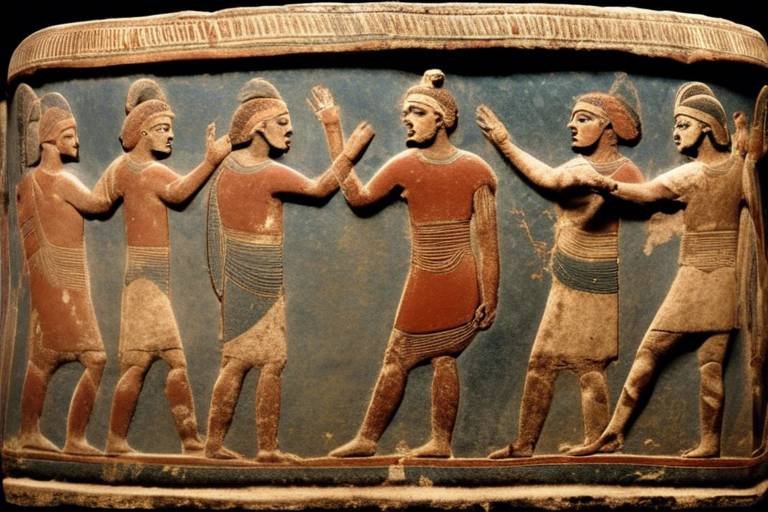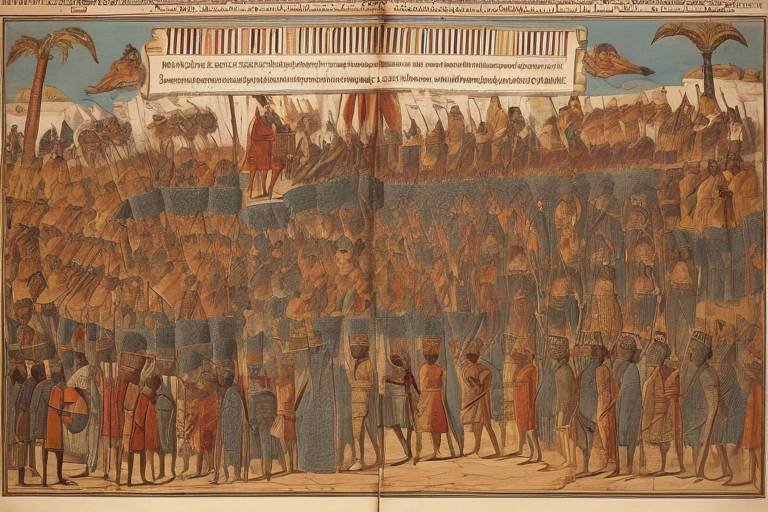The Mystery of the Lost Civilizations of Eastern Africa
Eastern Africa is a land shrouded in mystery, where ancient civilizations once thrived before vanishing into the sands of time, leaving behind enigmatic ruins and archaeological puzzles that continue to captivate researchers and historians. The region holds a treasure trove of lost histories waiting to be uncovered, offering glimpses into the rich tapestry of its past.
Among the most intriguing remnants of these lost civilizations are the Great Zimbabwe Ruins, a testament to the architectural prowess of a bygone era. The intricate stone structures of Great Zimbabwe stand as silent witnesses to a once-thriving city, now a UNESCO World Heritage Site that beckons visitors to unravel its secrets and marvel at its grandeur.
Delving further into the historical depths of Eastern Africa, one encounters the Kingdom of Aksum, a civilization known for its towering obelisks and formidable trading power. The legacy of Aksum, with its advanced civilization and mysterious decline, presents a puzzle that continues to intrigue scholars, offering a glimpse into a lost world of splendor and influence.
Amidst the rugged landscapes of Ethiopia lies the enigmatic Lalibela, home to rock-hewn churches carved out of solid rock in a feat of architectural mastery. These mysterious churches, steeped in legend and mystery, raise questions about the motivations behind their creation and the techniques employed by their ancient builders.
Venturing to the ancient port city of Adulis, once a bustling trade hub in the Red Sea region, one encounters a vanished civilization that left behind tantalizing clues for modern researchers to decipher. The remnants of Adulis offer a glimpse into a vibrant past, sparking curiosity about the forces that led to its disappearance from historical records.
Exploring the nomadic Beja people of Eastern Africa reveals a culture intertwined with the region's lost civilizations, offering insights into their role in shaping the ancient landscape. The Beja people, with their rich cultural heritage and enigmatic history, add a layer of complexity to the narratives of the past.
Further south, the ruins of Kilwa Kisiwani stand as a testament to the medieval Swahili trading city that once thrived on the East African coast. These ruins, showcasing advanced architecture and cultural exchange, hint at a prosperous past overshadowed by a mysterious decline that puzzles historians to this day.
Turning westward, the ancient stone circles of Senegal stand as silent sentinels of past civilizations, believed to be burial grounds or celestial observatories. These stone circles, designated as a UNESCO World Heritage Site, reflect the spiritual and scientific knowledge of the ancient peoples who once inhabited the region.
Lastly, the rise and fall of the Kingdom of Kush in Nubia, Sudan, offers a glimpse into the ebb and flow of power in Eastern Africa. Known for its pyramids, temples, and powerful rulers, the Kingdom of Kush's decline and disappearance from the historical landscape raise questions about the factors that shaped the destiny of this once-mighty civilization.

The Great Zimbabwe Ruins
The Great Zimbabwe Ruins stand as a testament to the once flourishing civilization that thrived in Eastern Africa. These impressive stone structures, characterized by intricate architecture and mysterious artifacts, have captured the imagination of historians and visitors alike. Designated as a UNESCO World Heritage Site, the Great Zimbabwe continues to puzzle researchers with its enigmatic past and the secrets it holds within its ancient walls.

The Kingdom of Aksum
The Kingdom of Aksum, located in present-day Ethiopia and Eritrea, stands as a testament to the ancient civilization that once thrived in Eastern Africa. Renowned for its towering obelisks, intricate coinage, and powerful trading network, Aksum was a dominant force in the region during its peak. The Aksumite civilization left behind a legacy of innovation and cultural richness that continues to captivate historians and archaeologists alike.
At the height of its power, the Kingdom of Aksum controlled vast territories, extending its influence across the Red Sea and into the Arabian Peninsula. Its strategic location allowed Aksum to flourish as a major trading hub, connecting Africa with the Mediterranean world and beyond. The Aksumites were skilled sailors and traders, facilitating the exchange of goods, ideas, and culture along ancient trade routes.
One of the most intriguing aspects of the Kingdom of Aksum is its enigmatic decline. Despite its impressive achievements and advancements, Aksum's influence began to wane around the 7th century AD, leading to the gradual abandonment of its monumental structures and the fading of its once-mighty civilization. The reasons behind this decline remain a subject of debate among scholars, with theories ranging from environmental factors to political upheaval.
The obelisks of Aksum, some of which still stand today, serve as a reminder of the kingdom's former glory. These towering stone monuments, intricately carved and adorned with symbols of power and prestige, are a testament to the artistic and engineering skills of the Aksumite civilization. The obelisks also hold clues to the religious beliefs and cultural practices of the ancient Aksumites.
Exploring the ruins of Aksum reveals a complex society that thrived on trade, agriculture, and craftsmanship. The Aksumites were known for their advanced agricultural practices, including terraced farming and irrigation systems that sustained their growing population. The kingdom's coinage, featuring unique designs and inscriptions, attests to its economic prosperity and sophistication.
Today, the Kingdom of Aksum remains a source of fascination and mystery, inviting visitors to delve into its rich history and uncover the secrets of its past. As archaeologists continue to excavate and study the remnants of this ancient civilization, new discoveries shed light on the enduring legacy of Aksum and its enduring impact on the history of Eastern Africa.

The Mysterious Lalibela Churches
The Mysterious Lalibela Churches in Ethiopia stand as a testament to human ingenuity and spiritual devotion. Carved entirely out of solid rock, these remarkable structures have puzzled archaeologists and historians for centuries. The intricate network of churches, interconnected by tunnels and passageways, raises questions about the advanced engineering techniques employed by the ancient builders. How did they manage to carve such intricate designs out of rock without modern tools? The Lalibela Churches are not merely architectural marvels; they are symbols of faith and dedication, drawing pilgrims and visitors from around the world to marvel at their beauty and mystery.

The Lost City of Adulis
The ancient port city of Adulis, located in present-day Eritrea, was a bustling hub of trade and commerce in the Red Sea region during antiquity. Its strategic location made it a key player in the maritime trade networks of the time, connecting the African interior with the Mediterranean world and the Arabian Peninsula. Adulis flourished as a vibrant center of cultural exchange, welcoming merchants and travelers from distant lands.
Archaeological excavations at Adulis have revealed remnants of a sophisticated urban settlement, including stone buildings, harbor structures, and artifacts from various ancient civilizations. The city's prosperity was evident in the diverse range of goods found in excavations, such as pottery, glassware, coins, and jewelry, indicating a thriving economy and extensive trade connections.
Despite its historical significance, the exact reasons for the decline and eventual abandonment of Adulis remain shrouded in mystery. The city gradually faded from prominence in the early centuries AD, disappearing from historical records and leaving researchers puzzled about the factors that led to its downfall. Theories suggest possible causes such as shifts in trade routes, environmental changes, or political instability.
Modern scholars continue to unravel the mysteries of Adulis through ongoing archaeological investigations and research efforts. The discovery of inscriptions, architectural remains, and artifacts provides valuable insights into the city's past, offering glimpses of its cultural diversity, economic prosperity, and interactions with neighboring regions.

The Enigmatic Beja People
The Enigmatic Beja People of Eastern Africa have long fascinated historians and archaeologists with their mysterious origins and cultural significance. These nomadic pastoralists have a rich heritage deeply intertwined with the ancient civilizations that once thrived in the region. The Beja people's presence in Eastern Africa raises intriguing questions about their role in the lost histories of the area and the connections they may have had with the enigmatic civilizations that have left behind puzzling remnants.

The Ruins of Kilwa Kisiwani
Exploring the enigmatic disappearance of ancient civilizations in Eastern Africa and the archaeological puzzles left behind, shedding light on the rich history of the region and the clues that researchers are uncovering.
Investigating the ruins of Kilwa Kisiwani takes us on a journey through time to a medieval Swahili trading city that once flourished on the East African coast. The remnants of this ancient city showcase advanced architecture, intricate design, and a complex urban layout that attest to its former glory. Kilwa Kisiwani was a hub of trade, culture, and exchange, connecting the East African coast to distant lands through maritime routes.
Walking through the ruins, one can't help but marvel at the craftsmanship and engineering skills of the inhabitants who built this vibrant city. The Great Mosque of Kilwa, with its ornate decorations and grandeur, stands as a testament to the spiritual and cultural richness of the civilization that thrived here. The intricate coral stone buildings and the well-planned streets hint at a society that valued art, architecture, and urban planning.
However, despite its past prosperity, Kilwa Kisiwani faced a mysterious decline that has puzzled historians and archaeologists. The reasons behind the city's downfall remain shrouded in mystery, sparking debates and theories about environmental changes, economic shifts, or political upheavals that might have led to its eventual abandonment. The enigmatic ruins of Kilwa Kisiwani continue to intrigue visitors and researchers alike, offering a glimpse into a bygone era of East African history.

The Stone Circles of Senegal
The Stone Circles of Senegal stand as a testament to the ancient civilizations that once thrived in the region, showcasing a remarkable blend of spiritual beliefs and scientific knowledge. These enigmatic stone formations, recognized as a UNESCO World Heritage Site, have puzzled researchers and visitors alike with their purpose and significance. Believed to serve as burial grounds or celestial observatories, the stone circles offer a glimpse into the advanced understanding of astronomy and cosmology held by past societies in Senegal.
The intricate arrangement of the stones reflects a deep connection to the natural world and the cosmos, with some circles aligning with specific astronomical events such as solstices and equinoxes. This alignment suggests a sophisticated understanding of celestial movements and the passage of time, highlighting the intellectual prowess of the ancient inhabitants who constructed these mysterious structures.
Archaeological excavations have revealed artifacts and human remains within the stone circles, shedding light on the rituals and beliefs of the people who built them. The intricate carvings and patterns found on some of the stones hint at a rich cultural and spiritual heritage, inviting speculation about the ceremonies and ceremonies conducted within these sacred spaces.
Despite the passage of centuries, the Stone Circles of Senegal continue to captivate the imagination of modern-day explorers and scholars, offering a window into the ancient past and the enduring legacy of the civilizations that once flourished in this region.

The Decline of the Kingdom of Kush
Exploring the enigmatic disappearance of ancient civilizations in Eastern Africa and the archaeological puzzles left behind, shedding light on the rich history of the region and the clues that researchers are uncovering.
Discussing the impressive stone structures of Great Zimbabwe, once a thriving city with intricate architecture and artifacts, now a UNESCO World Heritage Site that continues to intrigue historians and visitors.
Unraveling the historical significance of the Kingdom of Aksum, known for its obelisks, trading power, and advanced civilization, which mysteriously declined in influence, leaving behind a legacy of mystery and wonder.
Exploring the rock-hewn churches of Lalibela, Ethiopia, carved out of solid rock in a complex architectural feat, shrouded in mystery and legend, raising questions about the techniques and motivations behind their creation.
Delving into the ancient port city of Adulis, a key trade hub in the Red Sea region, which thrived in antiquity before vanishing from historical records, leaving behind tantalizing clues for modern researchers to decipher.
Examining the enigmatic Beja people of Eastern Africa, nomadic pastoralists with a rich cultural heritage and a history intertwined with ancient civilizations, offering insights into their role in the region's lost histories.
Investigating the ruins of Kilwa Kisiwani, a medieval Swahili trading city that flourished on the East African coast, showcasing advanced architecture, trade networks, and cultural exchange, yet facing a mysterious decline.
Exploring the ancient stone circles of Senegal, a UNESCO World Heritage Site, believed to be burial grounds or celestial observatories, reflecting the spiritual and scientific knowledge of past civilizations in the region.
Tracing the rise and fall of the Kingdom of Kush in Nubia, Sudan, known for its pyramids, temples, and powerful rulers, exploring the factors that led to its decline and disappearance from the historical landscape.
Q: What caused the decline of these ancient civilizations in Eastern Africa?
A: The decline of these civilizations could be attributed to a combination of factors such as environmental changes, political instability, and economic challenges.
Q: Are there ongoing archaeological excavations in these regions?
A: Yes, researchers continue to conduct excavations and studies in Eastern Africa to uncover more about the lost civilizations and their mysteries.
Q: How can visitors explore these ancient sites?
A: Many of these sites are open to visitors, offering guided tours and insights into the rich history and culture of the region.
Frequently Asked Questions
- What caused the decline of the ancient civilizations in Eastern Africa?
The decline of these civilizations is a subject of much debate among researchers. Factors such as environmental changes, political instability, and economic shifts have been proposed as potential causes. The exact reasons behind their disappearance remain a mystery, adding to the allure of these lost cultures.
- How were the stone structures at Great Zimbabwe constructed?
The construction techniques used at Great Zimbabwe are still a topic of discussion. The intricate stone walls and structures were built without mortar, using a method that has puzzled experts for years. The precision and scale of the architecture continue to fascinate visitors and archaeologists alike.
- What is the significance of the Lalibela Churches?
The Lalibela Churches are renowned for their unique construction, carved directly into the rock. These churches hold great religious and historical importance in Ethiopia, with their intricate designs and mysterious origins captivating visitors from around the world.
- Why did the Kingdom of Aksum decline?
The decline of the Kingdom of Aksum is a complex historical puzzle. Various factors, including shifts in trade routes, environmental changes, and internal conflicts, have been suggested as contributing to its downfall. The legacy of Aksum's advanced civilization continues to spark curiosity and exploration.
- What is the significance of the stone circles in Senegal?
The stone circles in Senegal are believed to have served as burial sites or astronomical observatories. These ancient structures offer insights into the spiritual and scientific knowledge of past civilizations in the region, highlighting the advanced skills and beliefs of the people who built them.



















